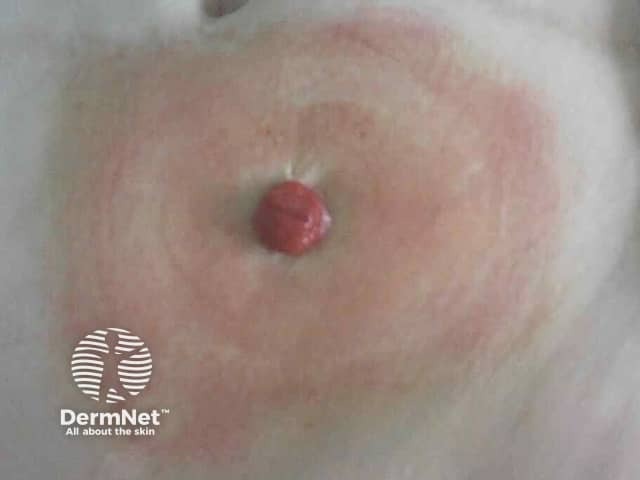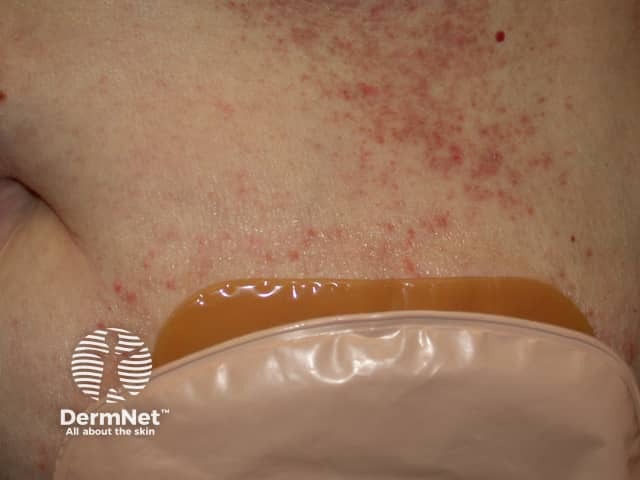Main menu
Common skin conditions

NEWS
Join DermNet PRO
Read more
Quick links
Author: A/Prof Amanda Oakley, Dermatologist, Hamilton, New Zealand, 2006. Minor update June 2023.
Introduction
Stomas and healthcare
Complications
Stoma appliances
Skin care
Skin infection
Inflammatory skin disease
Topical corticosteroids
Worldwide, millions of individuals have stomas. Skin problems relating to the stoma are extremely common.
A stoma is a surgically created opening of the intestinal or urinary tract on to the body surface. Stomas most often open via a short spout onto the surface of the abdominal wall. They may be permanent or temporary (another surgical operation is required to rejoin the bowel).
Common reasons for an ileostomy include:
Common reasons for a colostomy include:
Common reasons for a urostomy include:
Early complications may include:
Later complications may include:
A specialist nurse will advise on the most appropriate appliance and will support a patient adjusting to life with a stoma.
The pouch may be pre-cut, or require cutting to the exact size and shape of the stoma to protect the surrounding skin from damage and to prevent leakage. The flange in contact with the skin is made of sticky hydrocolloid. The pouch is made of clear or flesh-coloured plastic.
Colostomy appliances may be a closed-end bag which can be changed once or twice each day, or an open-ended bag that may be drained as required. Ileostomy bags are drainable and changed every two or three days. Urostomy pouches may also be drained as required and changed every two or three days. Bags may be one-piece or two-piece, closed or drainable.
Carefully designed products have the following properties:
New skin-protective technology with an ostomy baseplate has been found to improve peristomal skin complications and is currently under investigation.
Micro-organisms may proliferate because the stoma is warm, humid and soiled. They may colonise the stoma without causing disease. True skin infection is more likely if the patient suffers from general ill-health or diabetes, or takes immunosuppressive medication.
Bacterial infections are confirmed by swabs. They may present as:
Cleansing with an antiseptic may be sufficient. Treatment with specific oral antibiotics may be necessary to clear more severe infection.
Fungal infections may be confirmed by skin scrapings. They may include:
Viral infections may include:
The skin around a stoma may become inflamed (red, swollen, painful) because the stoma is leaking, because of an underlying skin disease, or because of infection.
Papules (small bumps) and nodules (large ones) can develop due to ongoing irritation, granulation tissue, viral warts, cancer or Crohn disease.
Ulceration may be due to trauma (surgery, appliance, clothing), wound breakdown (pyoderma gangrenosum, malnutrition), medications (e.g. nicorandil) or skin disease.

Irritant contact dermatitis

Spreading autosensitisation reaction

Pyoderma gangrenosum
Unfortunately many people with a stoma suffer from skin irritation from time to time. The main causes are:
The appliance may leak for the following reasons:
The result is irritant contact dermatitis i.e. red papules (small bumps) and plaques (larger thickened patches) and scaling. The dermatitis may affect a crescent area below the appliance or affect the whole area in contact with it. It may be very sore or itchy.
Treatment of the dermatitis may include:
Prolonged irritation may result in over-granulation (moist red thickened areas), warty papules and pseudoepitheliomatous hyperplasia (cancer-like growths). Treatment may include:
Allergy to acrylic adhesive or resin components of the appliance is rare. The appearance is similar to irritant contact dermatitis but allergic contact dermatitis affects all areas in contact with the appliance, and may also spread more widely to surrounding or distant skin.
Allergy may also be due to a deodoriser, fragrance or preservative such as parabens, kathon cg or imidazolidinyl urea in a cleanser. If dermatitis is very persistent, patch tests should be performed to relevant allergens such as the standard series, glues and plastics, preservatives, fragrances and medicaments.
Granulomas are lumpy lesions due to inflammation in the dermis. Stomal granulomas may be due to:
The skin surrounding the stoma may be discoloured.
Psoriasis presents as patches of scaly red skin. It may arise around a stoma in patients who have psoriasis in other sites or who have a genetic predisposition to it. It is particularly common in patients who have inflammatory bowel disease. Stripping off the skin when the appliance is changed may provoke psoriasis (this is known as the Koebner reaction).
Plaques of psoriasis are generally sharply defined. They tend to extend beyond the stoma and may be more prominent outside it because the moist environment under hydrocolloid may be beneficial in treating psoriasis.
Psoriasis relating to a stoma may be treated with topical steroids (see below). Occasionally other treatments such as phototherapy, methotrexate or ciclosporin may be necessary.
Pyoderma gangrenosum is an painful ulcerating skin disorder. It is sometimes associated with inflammatory bowel disease or cancer. The ulcers may be triggered by an injury to the skin, such as trauma from a tight appliance or surgery. This is known as pathergy.
Treatment may include topical steroids (see below), topical tacrolimus, systemic steroids, ciclosporin, dapsone and minocycline. Further surgery should be avoided if possible, as it may provoke larger ulcers.
Seborrhoeic dermatitis may appear similar to irritant dermatitis or psoriasis, causing a scaling pink rash around the stoma as well as other typical sites (scalp, behind ears, nose crease, chest, under arms and navel).
Treatment involves antifungal lotions and occasional courses of topical steroids (see below).
The following skin conditions should be considered if a rash affects a stoma or there is delayed wound healing:
Topical steroid lotions or scalp solutions may be used directly onto the stoma when the bag is changed to treat inflammatory skin conditions including dermatitis, psoriasis and pyoderma gangrenosum.